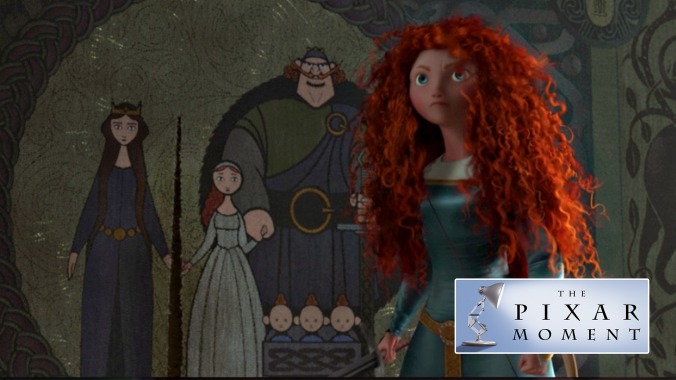Pixar’s Brave both challenged and upheld the Disney princess tradition
Image: Screenshot: Brave
Brave, Pixar’s 13th film, marked multiple milestones for the animation studio. It was the first Pixar movie to center on a female protagonist, as well as the first to be directed by a woman—Brenda Chapman, who also has the distinction of being the first woman ever to helm an animated feature for a major studio. When work began on the film, Pixar implemented a new animation program, Presto, to render a digital version of the Scottish Highlands that was almost as lush and gorgeous as the real thing. Brave also represented Pixar’s first foray into Disney’s most cherished territory: princess movies.
But Brave isn’t your typical Disney princess tale, not even after Disney crowned Merida one of its own in 2013, just one year after the film’s release. The story was first conceived of by Chapman in 2006, the year the Disney-Pixar merger was finalized. Chapman took inspiration from her Scottish ancestry and her own relationship with her plucky daughter, and began to weave a story about a spirited medieval princess, her overbearing but well-meaning mother, and a bear. All elements that could easily fit into the Disney template, with which Chapman was quite familiar: She’d worked as a writer and storyboard artist on several Disney films, including The Little Mermaid and Beauty And The Beast, before directing Dreamworks’ The Prince Of Egypt.
Under Chapman’s early guidance, the core relationship of the film was between Merida (voiced by Kelly Macdonald) and her mother Elinor (voiced by Emma Thompson). Their dynamic is loving but tense; Elinor tries to prepare Merida for a life of leadership and diplomacy, while Merida strains against the confining conventions of being a princess. Things come to a head early in the film, when, during a contest for her hand in marriage, Merida rejects and roundly embarrasses the sons of the lords of the three clans that, along with her own family, the DunBrochs, form some vague alliance that needs bolstering in the form of a political marriage. At her wit’s end, Elinor insists Merida fall in line, ignoring everything her daughter is trying to tell her about wanting to forge her own path in life. Merida snaps, calls her mother a “beast,” tells her she’ll never be like her, and takes her sword to the family tapestry.
Elinor is hurt by Merida’s lashing out, but she still commands her: “You are a princess. I expect you to act like one.” Their rift is what sets the story in motion, as Brave loops in that other Disney standby, a witch, and embarks on a trip wherein the two sparring parties learn to see the world through each other’s eyes. But where Brave diverges from the formula is in keeping its focus on the relationship between mother and daughter. There’s no handsome prince who helps Merida soften her views, either on marriage or her mother’s strict ways. Instead, there is Elinor as a bear (the result of a potion from a witch who admits she’s not great at her job), whom Merida looks after, fiercely and tenderly. As they work to undo the spell before it’s too late—while also evading another cursed bear and King Fergus (Billy Connolly)—Elinor and Merida finally begin to understand each other.
But it’s not just the lack of a love interest that sets Brave apart from other Disney princess stories. Chapman refused to cast Merida from the same wasp-waisted mold as so many other female Disney leads. Pixar showed its commitment to her vision by using Presto to create Merida’s intricate mass of hair, a mane as unruly as the little Scottish archer sporting it. Elinor’s very presence also marks a significant departure; the majority of Disney princesses are motherless, or treated horribly by stepmothers. But though she is caring, Elinor represents, for much of the film, stifling conventions and gender roles, and therefore still stands as an obstacle for Merida to overcome. The two women eventually decide to defy tradition together, leaving room for everyone to “write their own stories.”
That’s a nice sentiment, but one that comes with an asterisk. With its feisty heroine, medieval setting, magical forest, and lesson-imparting original music, Brave still looked and sounded like its House Of Mouse predecessors. In fact, it’s probably the most traditional Disney movie Pixar’s ever made, despite its commentary on convention. Even one of the film’s firsts is qualified—Chapman was removed as director in 2010 by John Lasseter, who comes with his own asterisk. Mark Andrews was brought in roughly two years before the film was set to be released. Chapman is still the only woman to ever direct a Pixar film; after 22 features (and counting), Merida is one of only three female Pixar protagonists. In the end, Brave could only break from so many traditions.